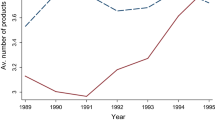Summaries
This article focuses on three important policy issues related to innovation in the chemical industry. First, what are the structural differences between the notification systems for new chemical substances in the EU, Japan and the USA? Second, evaluation of the innovative performance of the chemical industries in these three regions. Third, determination of whether the differences observed can be attributed in part to the structural differences of the regulatory systems. The conclusions drawn are based on both a quantitative examination of the large and medium-sized stock-issuing companies of the industry, and on a qualitative analysis using the case study approach.
Résumé
Cet article porte principalement sur trois importantes questions de politique relatives à l’innovation dans l’industrie chimique. En premier lieu, un examination des différences de structure entre les systèmes de notification pour les nouveaux produits chimiques dans l’UE, au Japon et aux Etats Unis. En deuxième lieu, une évaluation de la performance innovative de l’industrie chimique dans ces trois régions. En troisième lieu, la détermination de si les différences observées peuvent être attribuées, en partie, aux différences de structure dans les systèmes de contrôle. Les conclusions tirées sont basées sur une examination quantitative des grandes et moyennes sociétés émettrices d’actions de l’industrie chimique aussi bien que sur une analyse qualitative qui utilise des études de cas.
Zusammenfassung
In diesem Beitrag werden drei zentrale Probleme der Chemikalienpolitik analysiert, die direkt und indirekt mit der Innovationsfähigkeit der chemischen Industrie zusammenhängen. Gestützt auf Ergebnisse eines internationalen Vergleichs der sehr unterschiedlichen Regulierung neuer chemischer Substanzen in der EU, in Japan und den USA werden Strukturunterschiede des Chemikalienrechts herausgearbeitet und untersucht, welche Auswirkungen des Chemikalienrechts im Innovationswettbewerb zu beobachten sind und welche Unterschiede in der Innovationsleistung auf Unterschiede in den Regulierungsansätzen zurückgeführt werden können.
Similar content being viewed by others
References
Fleischer M, S Kelm, D Palm and L Delgado (ed),Regulation and Innovation in the Chemical Industry, Institute for Prospective Technological Studies (IPTS), Publication EUR 19735 EN, Sevilla, 2000 (Internet: ftp://ftp.jrc.es/pub/EURdoc/eur19735en.pdf)
Neven B, R Schubert and L Bontoux (ed),Comparison of Regulatory Requirements for the Notification of New Chemical Substances in the European Union, the USA and Japan, Institute for Prospective Technological Studies (IPTS), Publication EUR 18119 EN, Sevilla, 1998 (Internet: ftp://ftp.jrc.es/pub/EURdoc/eur18119en.pdf)
Clarke E and H Motschi, ‘Regulatory and legislative aspects of relevance to high performance pigments: Europe’,High Performance Pigments, H M Smith (ed), 381–410 Wiley-VCH, Weinheim, 2002
Moore J, ‘Chemical control and new substances notification in Japan: A supplier’s view’, R Feierl (ed), 98–110, ChemCon ’98, Vienna Conference on International Chemical Regulations, Punkt Zwoelf Verlag, Wien, 1998
Fitzpatrick H F and G C Merritt, ‘Regulatory affairs for high performance pigments: North America’,High Performance Pigment, H M Smith (ed), 363–97, Wiley-VCH, Weinheim, 2002
European Commission, ‘Three-yearly report on the implementation of Directive 67/548/EEC on the Classification, Packaging and Labelling of Dangerous Substances, as amended by Directive 92/32/EEC’, Brussels, May 1998 (Internet: http://europa.eu.int/comm/environment/dansub/3year_rep.pdf)
Institute for Environment and Health (IEH), ‘Testing requirements for proposals under the EC White Paper’,Strategy for Future Chemicals Policy, IEH Web Report W6, Leicester, July 2001 (Internet: http://www.le.ac.uk/ieh/contact/contact.html)
Albach H, D B Audretsch, M Fleischer, R Greb, E Höfs, L-H Röller and I Schulz, ‘Innovation in the European chemical industry’, Discussion Paper FS IV, 96–26, Wissenschaftszentrum Berlin, 1996 (Internet: http://skylla.wzberlin.de/pdf/1996/iv96-26.pdf)
Hollins S M and R B Macrory,Impact of the Directive 67/548/EEC on Small & Medium Sized Enterprises (SMEs) with Reference to Specialist Chemical Companies, Imperical College Consultants Ltd, London, 1994
European Commission, ‘Strategy for a future chemicals policy’, White Paper: COM(2001), Brussels, 27th February 2001 (Internet: http://europa.eu.int/comm/environment/chemicals/whitepaper.htm)
OECD,Environmental Outlook for the Chemicals Industry, Paris, 2000 (Internet: http://www.oecd.org/ehs/)
Author information
Authors and Affiliations
Corresponding author
Rights and permissions
About this article
Cite this article
Fleischer, M. Regulation and innovation in the chemical industry: A comparison of the EU, Japan and the USA. Surface Coatings International Part B: Coatings Transactions 86, 21–29 (2003). https://doi.org/10.1007/BF02699589
Issue Date:
DOI: https://doi.org/10.1007/BF02699589




